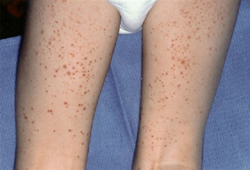History and exam
Key diagnostic factors
common
rash
Skin lesions are characterized as palpable purpura and are typically non-blanching.[Figure caption and citation for the preceding image starts]: Palpable purpura on the lower extremities of a childFrom the collection of Paul F. Roberts, MD [Citation ends].
The lesions are usually 2 to 10 mm in diameter, and represent the extravasation of blood into the skin. Lesions usually occur in crops and fade over several days to weeks and are typically concentrated on the legs and buttocks. The rash of IgAV occurs in all patients, but may not be the first presenting sign.
arthralgias
Can be present, often associated with edema; the knees and ankles are most often affected.
Present in about 80% of patients. Generally do not cause any long-term problems.
abdominal pain
Occurs in about half of patients, often associated with nausea and vomiting.
signs of renal disease
Occurs in about 40% to 50% of patients, and can vary from mild (i.e., asymptomatic hematuria and/or proteinuria) to severe (i.e., rapidly progressive nephritis, nephrotic syndrome, and renal failure). It can produce microscopic hematuria, proteinuria, and RBC casts.[21]
Other diagnostic factors
uncommon
drug history
scrotal pain or swelling
Occurs in about 13% of boys with IgAV.[9]
headaches
This is a rare manifestation.
seizures
This is a rare manifestation.
pulmonary hemorrhage
This is a rare manifestation.
Risk factors
strong
genetics
allergy
male sex
Males are more often affected than females at a ratio of up to 2:1.[12]
age 2 to 10 years
IgAV can occur at any age but is mainly a disease of childhood that occurs predominantly between the ages of 2 and 10 years. Peak incidence is between 4 and 7 years.[11]
increasing age at onset
Use of this content is subject to our disclaimer